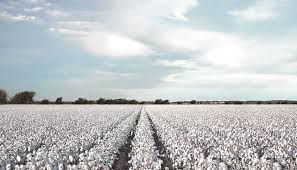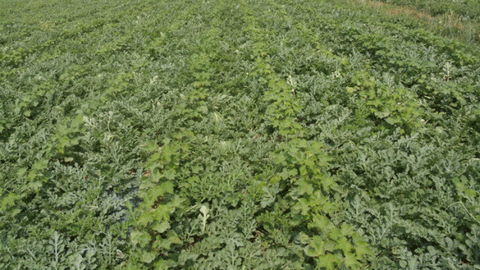
Organic Cotton-
An incredibly versatile fiber crop, every part of the cotton plant is used in a wide array of applications, ranging from clothing, to food, to explosives. As a textile, it can be woven into hearty protective canvas or silky smooth linens with impossibly high thread counts. Cotton is a staple in clothing because it feels good. It breathes. It moves with you and you forget you’re wearing it.
Although it’s history is difficult to track precisely, cotton was domesticated simultaneously in different parts of the world as early as 6500 years ago. In the decades following World War II, industrial agriculture was developed and quickly became the dominant method for farming in the US, featuring enormous single-crop farms. This large scale single-crop, or monoculture, farming was at first welcomed as a technological triumph and a way to enable the world, whose population was growing at an unprecedented rate, to feed itself. Today, corn, wheat, soybeans, rice, and cotton are all commonly grown this way in the US and it’s become more and more clear that it is an unsustainable method for growing crops over the long term.

Growing the same plant in the same place over and over quickly drains the soil of its natural biodiversity and makes it susceptible to erosion, so synthetic fertilizers are used to provide the plant with nutrients. Pesticides are needed because monoculture fields are highly attractive to certain weeds and insect pests, which overtime build up resistances to the pesticides, necessitating stronger pesticides, which the pests again build up resistances to, necessitating stronger pesticides, and so on.

These toxic chemical inputs and monoculture farming practices jeopardize soil, air, and water quality, and conventional cotton requires more chemicals than any other single crop. It’s estimated that conventional cotton uses 10 percent of all agricultural chemicals and 25 percent of the world’s insecticides. In the US, one-third of a pound of chemicals is needed to grow enough conventional cotton for a single t-shirt. That means that just like toxic paint, a t-shirt can off-gas chemicals that can affect your body’s systems and functions.
Instead of using toxic chemicals, organic farmers use beneficial insects, crop rotation, intercropping (planting several crops together), compost, cover crops, and weed by hand or machine in order to build soil quality, enhance biodiversity, and protect the air and water on which we depend.

Cotton and watermelon grow together in a south Georgia field.
Let’s quickly examine one organic farming method- intercropping. Trap crops can be used to divert pests away from the main crop. For example, sunflower can be sewn along with, or soon after cotton, so that it flowers at the same time bollworms would normally attack the cotton. The flowers attract predatory insects and birds which feed on the bollworms. The productivity of the sunflower is hardly affected by the bollworms, and the sunflower seeds can provide additional income for farmers. This is just one example of a huge number of possible crop combinations that naturally keep pests and weeds at bay, increasing yields and keeping soil, water, and air healthy and clean.
The benefits aren’t limited to the field. Without the presence of the synthetic chemicals used in conventional cotton production, the growers, harvesters, weavers, cutters, sewers, retailers- everyone on down the line, all the way to you, the consumer, is better off.
The Union of Concerned Scientists - www.ucsusa.org - is a great resource for learning about food and agriculture, clean energy, climate change, nuclear power and nuclear weapons, and just about any other subject that affects us all.
I used them as a reference for information in this post, along with the Organic Exchange Farmer Toolkit, available here - http://farmhub.textileexchange.org/upload/library/Farmer%20Toolkit/farmer_inter.pdf and compiled by the OE Farm Development Team. A list of sources and other publications on organic farming are available from Organic Exchange at www.organicexchange.org
I also used these as reference, and they’ll provide you with more information on industrial farming and on organic vs. conventional cotton.
http://www.ucsusa.org/our-work/food-agriculture/our-failing-food-system/industrial-agriculture#.VdZvHixViko
http://life.gaiam.com/article/how-eco-organic-cotton-facts-7-questions
